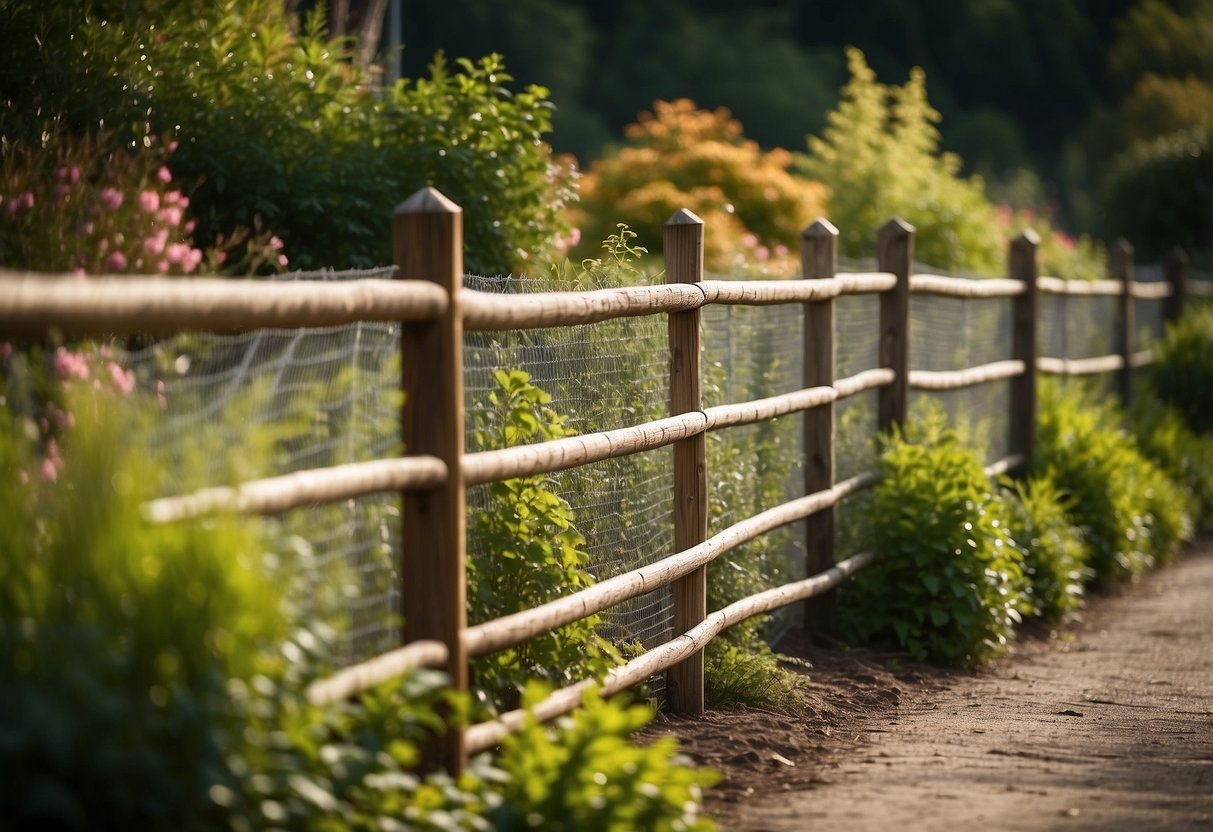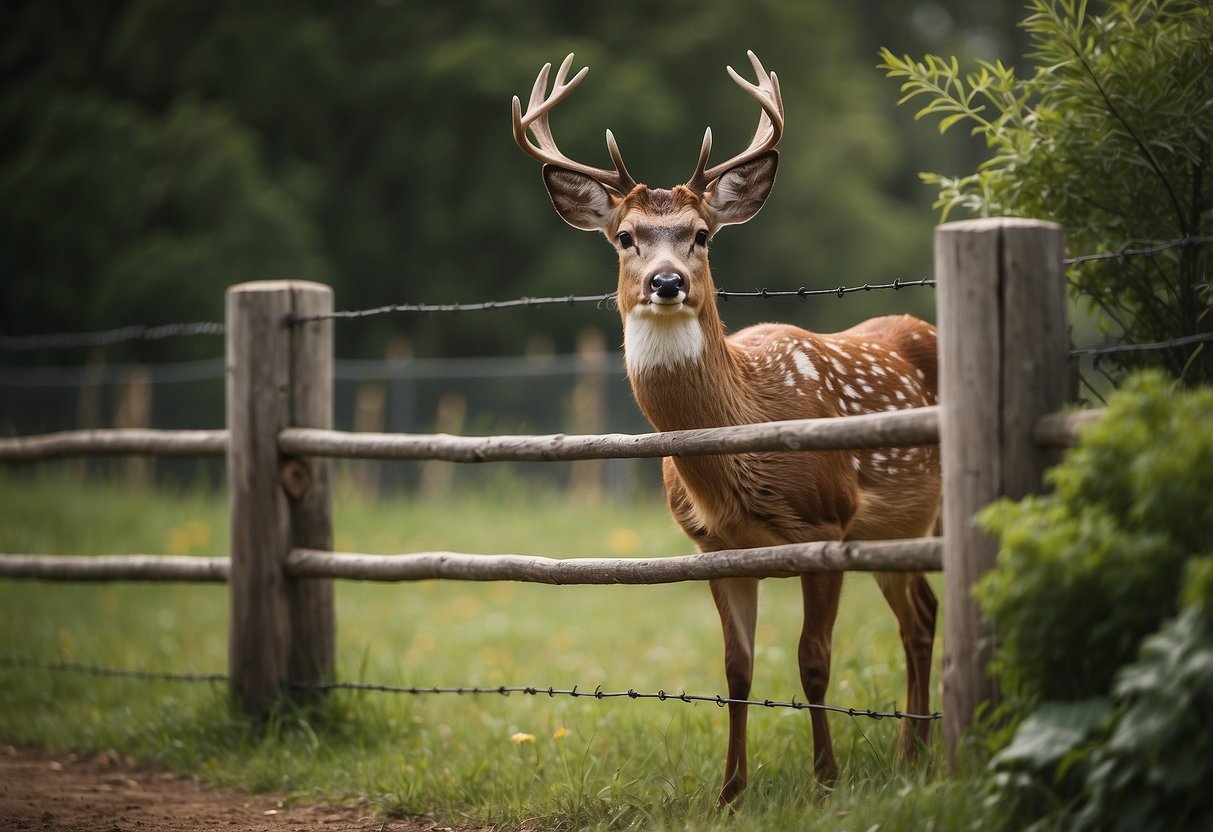Garden Fence Ideas To Keep Deer Out: Creative Solutions for a Beautiful Garden
Gardening can be a peaceful and rewarding hobby, but it can also be frustrating when deer decide to feast on your plants. Finding the right garden fencing solution is key to keeping these unwanted visitors out and protecting your hard work. By exploring different garden fence ideas, you can determine the most effective and practical options for your needs.

Every garden and situation is unique, so it’s crucial to consider various factors when planning your fence. These might include the size of your garden, the type of plants you are growing, and the local deer population. Choosing the right fence can make a huge difference in ensuring your garden thrives without the worry of deer damage.
1) Tall Mesh Fencing

Tall mesh fencing is a highly effective way to keep deer out of your garden. Make sure your fence is at least eight feet tall to prevent deer from jumping over it.
Options like black polypropylene mesh blend well with the surroundings, making them nearly invisible. This type of fencing is durable and a good investment for your garden protection.
Regularly check for any damage or gaps to ensure the fence remains effective. With tall mesh fencing, you’ll have a strong barrier against those pesky deer.
2) Electric Deer Fence

An electric deer fence uses wires that carry mild shocks to deter deer. These fences influence deer behavior without constant physical barriers.
Installing an electric fence is a good option if you want less visual obstruction in your garden.
Check local zoning laws before installing, as some areas may have restrictions.
3) Split Rail Fencing with Mesh

Split rail fencing with mesh combines rustic charm with practical effectiveness. The wooden rails give your garden a natural look, while the added mesh ensures that deer stay out.
You can use a sturdy mesh with a high breaking load to make it durable. The mesh is nearly invisible, so it won’t ruin the aesthetic of your yard.
This fencing style is great because it blends well with nature and offers good protection against deer. It is an affordable and attractive option for many gardens.
4) Black Polypropylene Deer Fence

Black polypropylene deer fences are a popular choice for gardens. They are highly durable and can withstand a breaking load of at least 800 pounds. This means they are strong enough to keep deer out.
The mesh is nearly invisible, so it won’t ruin the look of your garden. Plus, it’s easy to install and adjust for any dips or hills.
For an affordable and effective option, check out different polypropylene deer fence types.
5) Wood and Wire Deer Fence

A wood and wire deer fence combines classic looks with strong protection.
Using wooden posts and wire mesh, this fence keeps deer out without blocking your view.
It’s a sturdy option that fits well in many garden styles. The wire mesh is durable and effective at keeping deer away from your plants.
With simple materials, you can build this fence yourself, saving money in the process.
6) Dual-Function Fencing

Dual-function fencing serves two purposes: keeping deer out and enhancing your garden’s look. This type of fence can be both practical and attractive.
For example, consider using a two-tiered fence system. It combines electric and polytape fences to effectively deter deer from entering your garden space.
Another option is combining a wooden or metal fence with garden-friendly designs, like trellises for climbing plants. This way, your fence not only protects but also beautifies your garden.
7) Deer Barrier Netting

Deer barrier netting is an effective way to protect your garden.
By using “invisible” deer netting, you can create a barrier that deer can’t see easily. This makes it less likely for them to try to jump over it.
The netting needs to be at least eight feet tall to keep deer out. Attach it to wooden or metal posts to ensure it stays in place.
For added security, choose a sturdy polypropylene mesh with a strong breaking load. This makes sure the netting won’t tear easily.
8) Invisible Deer Fence

An invisible deer fence can make your garden look open while still protecting it from deer. This type of fence uses black mesh netting that blends into the background.
To set one up, fasten the netting to garden posts like wooden 4x4s or metal t-bars. The fence should be at least 8 feet tall to prevent deer from jumping over it, as they are great jumpers.
This method is effective and doesn’t interfere with the beauty of your garden. The mesh is durable and a great way to keep your plants safe from hungry deer.
9) Deer-Proof Garden Trellis

A deer-proof garden trellis is a great way to keep deer out while supporting climbing plants.
You can use strong materials like metal or wood for the trellis. Attach a wire mesh to the trellis to make it harder for deer to get through. Ensure that the trellis is tall enough to prevent deer from jumping over it.
Enhance your garden’s beauty and keep it safe with a well-built deer-proof garden trellis.
10) Motion-Activated Sprinklers

Motion-activated sprinklers are a great way to keep deer away from your garden. These devices detect movement and spray water, which startles the deer and makes them run off.
You can place these sprinklers at various points around your garden to create a safe perimeter. Plus, they also help water your garden!
Make sure to check the sensitivity settings and water pressure for optimal results.
Understanding Deer Behavior

Deer are a common problem for many gardeners because they are often drawn to the fresh plants and foliage. Their activity levels and behaviors change with the seasons, which impacts how they interact with your garden.
Why Deer Are Attracted to Gardens
Deer find gardens appealing due to the abundance of food. Fresh vegetables, fruits, and flowers are like a buffet for them.
Different plants attract deer more than others. For example, tender greens, berries, and certain types of flowers like tulips are particularly enticing.
Common Reasons Deer Are Attracted:
- Food Source: Gardens offer a variety of plants they enjoy.
- Easy Access: Often, gardens are open and easily accessible.
- Shelter: Gardens near wooded areas provide quick refuge.
You can reduce attraction by planting deer-resistant species and using barriers.
Seasons and Deer Activity
Deer behaviors change with the seasons. In spring and summer, they are more active and visible because they are foraging for fresh food.
During fall, deer increase their eating habits to build fat for winter. You might notice more activity in your garden as they seek out nutrient-dense foods.
Seasonal Behavior Patterns:
- Spring & Summer: High activity due to food availability.
- Fall: Increased garden visits to prepare for winter.
- Winter: Less active, but may still forage if food is scarce.
Understanding these patterns helps in planning your fencing and other deterrents more effectively.
Choosing the Right Fence

When planning your garden fence to keep out deer, key factors to consider include the height and structure of the fence, as well as the materials and their durability. These elements will help ensure your garden remains protected.
Fence Height and Structure
Height is a crucial factor. Deer can easily jump over short fences. To prevent this, a fence should be at least eight feet tall. Some gardeners opt for angled fences, which can deter deer more effectively.
Additionally, you can use a combination of fencing types. For example, use a tall privacy fence made from wood or vinyl. Another method is to install double fencing, creating a barrier wider than the deer can jump.
Spacing between fence posts is also important. Posts should be placed every 8-10 feet to maintain the structure’s integrity. This helps keep the fence tight and less likely to sag.
Materials and Durability
Choosing the right material will depend on your budget and aesthetic preferences. Common materials include wood, vinyl, metal, and polypropylene mesh. Polypropylene mesh is flexible, affordable, and almost invisible.
Wood and vinyl provide a solid barrier that can also add privacy to your garden. These materials are durable and can withstand various weather conditions. They do require regular maintenance to prevent wear.
For a more low-maintenance option, consider metal or composite fencing. These materials are durable and provide reliable protection. Metal fences can be reinforced with support wires to prevent sagging and increase stability. Using the right materials will ensure your fence remains effective and long-lasting, keeping your garden safe from deer.
Implementing Additional Deterrents

To keep deer out of your garden, you can use natural repellents and motion-activated devices. These methods help manage deer without harming them, and they can complement your existing fence setup.
Using Natural Repellents
Natural repellents are a great way to keep deer out of your garden. Cayenne pepper mixed with water can be sprayed around your garden beds. This method is quite effective because deer find the smell unpleasant. Apply it once a week for the best results.
Scents like human hair or soap are also useful. Place a mesh bag of hair or hang bars of scented soap around the garden. Deer dislike these smells and are likely to stay away.
Homemade mixes such as garlic or egg sprays can also work well. Mix garlic, eggs, and water, and spray it on plants. These scents deter deer from munching on your hard work.
Integrating Motion-Activated Devices
Motion-activated devices scare deer away by startling them. Motion-activated sprinklers are especially effective. When a deer gets close, the sprinkler activates and sprays water. This sudden movement and noise frighten the deer, making them think twice about returning.
Solar-powered lights that flicker on when they sense movement can also be useful. Deer are usually scared of sudden light, which makes them stay away from your garden at night.
Noisemakers, like alarms or radios set on timers, can help too. Devices that produce random noises can confuse and scare deer, preventing them from becoming comfortable in your garden.
Using these motion-activated devices, you can protect your garden easily without constantly monitoring it.
Maintaining Your Garden Fence

Keeping your garden fence in good shape is important to ensure it continues to keep deer out.
Check Regularly: Walk around your fence at least once a week. Look for any signs of wear and tear.
Repair Damage: Fix any holes or loose wires immediately. Deer can quickly find and exploit weak points.
Clean the Fence: Keep your fence clean from dirt and debris. Use a brush or hose to wash off any build-up.
Tighten the Mesh: Mesh fences can sag over time. Check the tension regularly. If it’s loose, use a support wire to tighten it.
| Maintenance Task | Frequency |
|---|---|
| Inspect for Damage | Weekly |
| Tighten Mesh | Monthly |
| Clean the Fence | Seasonally |
| Fix Holes and Loose Wires | As needed |
Treat Wooden Posts: If you have a wooden fence, treat the wood yearly to prevent rot. Use a wood preservative or sealant.
Monitor Gate Areas: Gates can be weak spots. Ensure they close properly and don’t have gaps. Install a latch that securely locks.
Bury the Fence: Make sure the bottom of your fence is buried at least 12 inches. This prevents deer from digging under.
Electric Fences: If you use an electric fence, check the battery and connections regularly. Test the current to make sure it’s working properly.
Taking these simple steps helps ensure your fence remains a reliable barrier against deer. Remember, consistent maintenance is the key.







